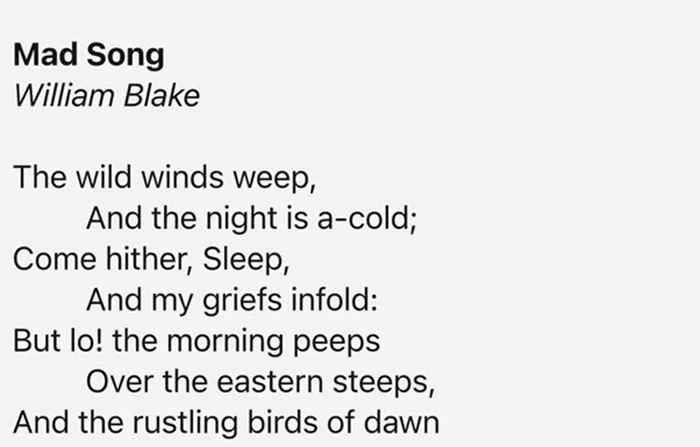Welcome to Poem of the Day – Mad Song by William Blake
William Blake, one of the most celebrated poets of the Romantic era, is known for his vivid imagery and profound exploration of the human experience. In his poem “Mad Song,” Blake delves into the tumultuous nature of emotions and the struggle between reason and passion. This brief yet powerful poem captures the intensity of the speaker’s inner turmoil, offering readers a glimpse into the depths of the human soul.
Mad Song Explanation
Overview of the Poem
“Mad Song” consists of a series of questions and exclamations that reflect the speaker’s emotional chaos. The poem is written in the first person, with the speaker expressing feelings of distress and confusion. The central theme is the idea of madness — not in the sense of mental illness, but as a metaphor for the overwhelming power of emotions and desires that can take control of an individual’s mind.
Analysis of the Poem
In the opening lines, Blake introduces the speaker’s disturbed state of mind. The repeated use of the word “mad” suggests that the speaker feels as though their emotions are uncontrollable and irrational. This establishes the central conflict of the poem: the struggle between the speaker’s inner turmoil and the social expectations of rationality.
Blake employs vivid, often disorienting imagery to capture the sense of madness. For example, the speaker refers to their “soul” as being “all in a tumult,” a striking image that highlights the intensity of their emotional state. The poem reflects the Romantic era’s fascination with the individual’s inner world, focusing on the raw, unfiltered aspects of human nature.
Symbolism in the Poem
Blake is known for his use of symbols, and “Mad Song” is no exception. The “madness” in the poem can be seen as a symbol for the uncontrollable nature of human passion. Blake suggests that reason and logic are not always the answer to life’s struggles. Instead, he emphasizes the importance of embracing the full range of human emotions, even if they seem chaotic or irrational.
The poem also touches on the theme of divine inspiration. In the later stanzas, the speaker references the “spirit” that guides them, implying that the madness may also be a form of divine madness — a state in which the speaker is in touch with something greater than themselves.
Conclusion
“Mad Song” by William Blake is a powerful exploration of the complexities of human emotion. Through vivid imagery and symbolic language, Blake expresses the intensity of inner turmoil and the tension between reason and passion. The poem challenges readers to consider the role of emotions in our lives and to recognize that madness, in Blake’s view, is not always a negative force. Instead, it can be a source of profound insight and creative energy.
Blake’s work continues to resonate today, reminding us that the full spectrum of human experience — including the wild, untamed aspects — is an essential part of our existence.

